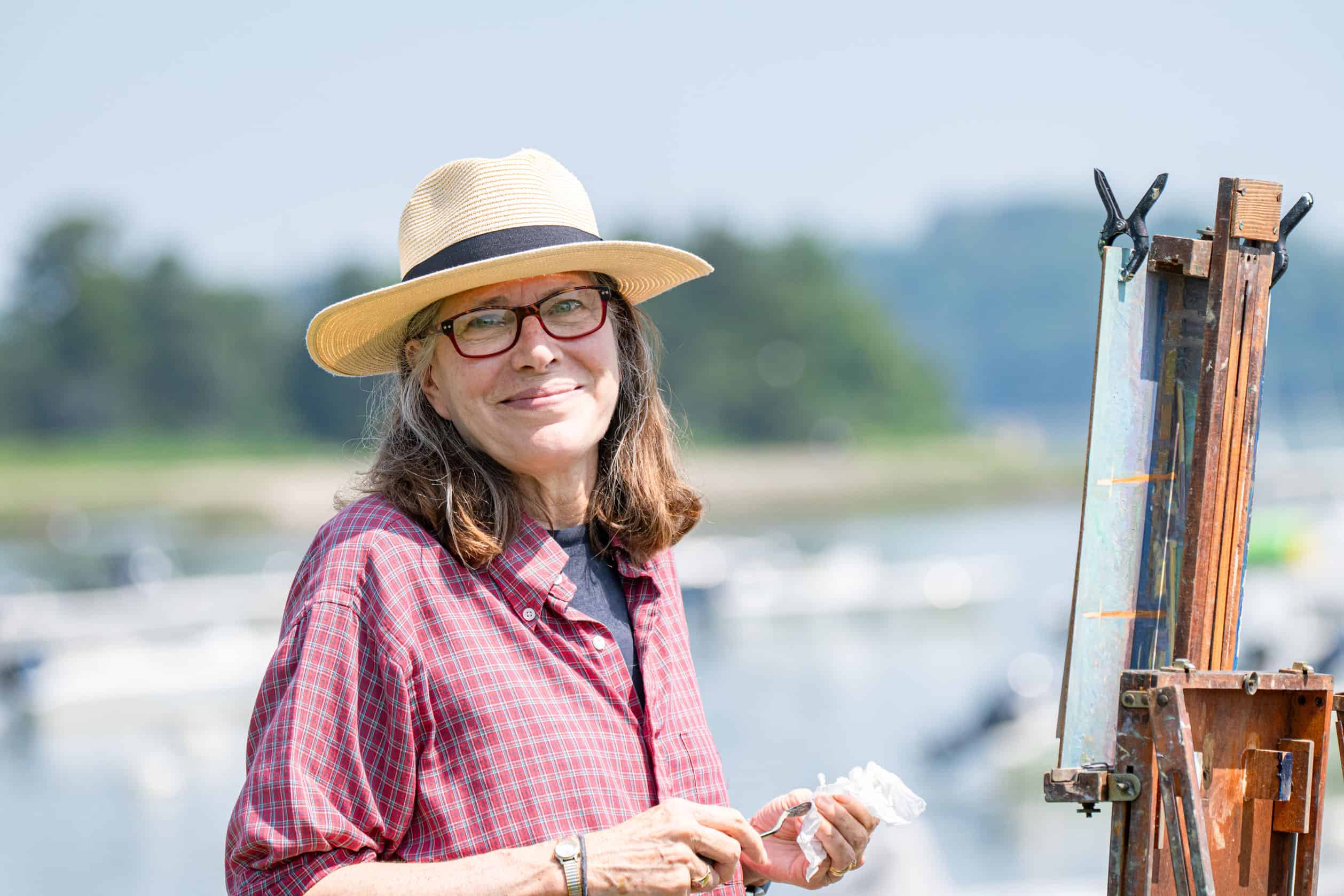Artist Margaret McWethy’s paintings depict scenes from everyday life and capture the beauty of the Hingham landscape.
By Maria Allen
Photography by Jack Foley
It’s 9 a.m. on a hot summer morning when Margaret McWethy arrives at Victory Park overlooking Hingham Harbor. With the sun rising in the sky, she sets up her artist’s easel in the shade of a small shed that has a prime view of the Hingham Town Landing. She gently drags a palette knife across a rectangular glass painter’s palette dotted with colorful globs of paint and begins to sketch out the rough shape of the marina’s wooden pilings and slanted railings that lead down to the docks. On this particular day, the Hingham resident is teaching a plein-air painting class and her students are spread out across the grassy hillside, each working quietly on their own miniature harbor landscape.
“It has always amazed me how well the town of Hingham has preserved its open space at the waterfront,” says McWethy. “Together with places like Turkey Hill and World’s End, it’s a painter’s paradise.”
A Maryland native, McWethy studied art history and biology at Swarthmore College before turning her focus to art. “I never really left science behind,” she says. “Every single painting is a puzzle to figure out. It’s a fun mental exercise.”

While she was always interested in art, McWethy admits her inspiration to take up painting was more of a happy accident. “I’d like to say that I always knew I wanted to be an artist but I took my first painting class because I met a guy who did it,” she says. It wasn’t long, however, until she found herself falling in love with the explorative nature of painting and she felt compelled to continue learning. McWethy studied at the Cape School of Art in Provincetown and it was there that she developed an eye for painting color and light, both in landscape and still-life subjects.
Since moving to Hingham 26 years ago, McWethy has become well known for her impressionistic paintings of iconic Hingham locales. Some of her most popular paintings have pictured scenes of Weir River Farm’s furry Galloway cows, the winding walking paths at World’s End and images of sailboats drifting across Hingham Bay.
McWethy has continued to develop her artistic skills and explore different painting techniques by challenging herself to paint in different ways. “Painting is a lot like golf because there are infinite variables,” she says. “For example, you can choose to paint on paper or linen, use a palette knife or a brush, or use a new brand of paint. By limiting or changing one of the variables, you can influence the outcome.”
When she’s painting local landscapes, McWethy will often spend up to three hours outside capturing the scene. She also takes photographs so that she can work at her home studio.
In some instances, she exercises artistic license to creatively enhance and edit things out of a scene so that her final images appear appealing to potential buyers. In some cases this could mean omitting visual clutter from the canvas, such as an unsightly eyesore, or adjusting the perspective of her subject.
McWethy has won a number of awards for her work and she is a featured artist in Lois Griffel’s “Painting the Impressionist Landscape,” Susan Sarbeck’s “Capturing Radiant Color in Oils,” and Lee Boynton’s “Painting the Impressionist Watercolor.” She is also a charter member of the New England Plein Air Painters and her work hangs in private and public collections in the United States, Europe and Canada. She also frequently does commissions for clients.

Many of McWethy’s Hingham landscape paintings are sold locally at Waterhouse Decor in downtown Hingham and she participates in the town’s annual Art Walk event in October. She also sells her work at Egeli Gallery in Provincetown, where she travels each summer to teach a class on still-life in the impressionistic tradition at the Cape School of Art. “I’m probably what you would call a colorist,” says McWethy. “I like to paint everyday things, like laundry that has been hung out to dry, lawn chairs, vases of flowers, and sewing stuff.” Her paintings skillfully capture the essence of these particular moments in time in a sentimental way.
Back on the South Shore, McWethy finds time to paint nearly every day, often heading down to the waterfront to reinterpret familiar scenes in a new way. “I’m always challenging myself to try different things and with shifting tides and boats coming and going in books like the harbor the landscape is constantly changing so I never get bored.”
For more information on Margaret McWethy’s art, visit margaretmcwethy.com.
